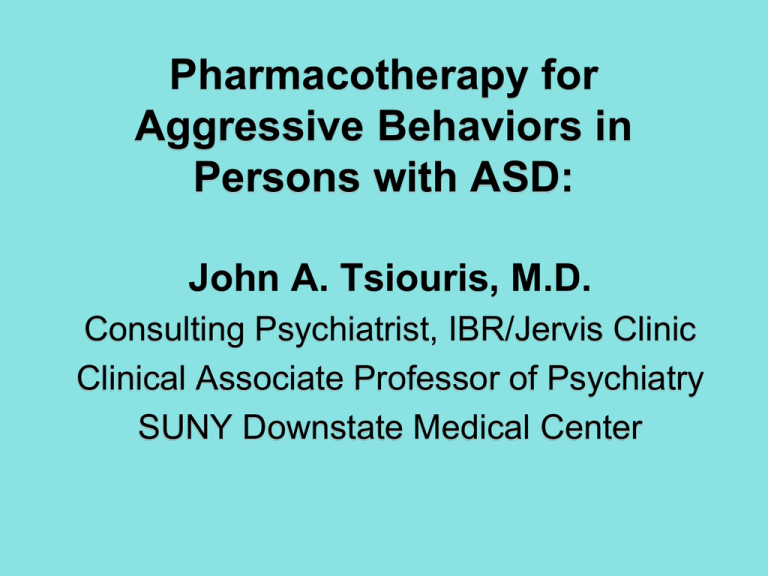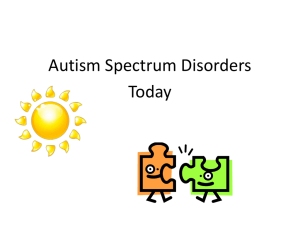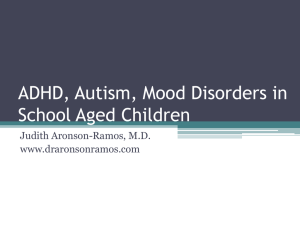
Pharmacotherapy for
Aggressive Behaviors in
Persons with ASD:
John A. Tsiouris, M.D.
Consulting Psychiatrist, IBR/Jervis Clinic
Clinical Associate Professor of Psychiatry
SUNY Downstate Medical Center
Autism Spectrum Disorder
Autistic Disorder
Asperger’s Disorder
PDD, NOS
Spectrum of Deficits/Abilities
Relatedness (moderate-to-severe
impairment)
Communication (none-to-very
good)
Sameness/Stereotypies (severe-tomild)
IQ (low-to-high) – 75% have an IQ
< 70
ASD is associated with:
Fragile X syndrome
PKU
Congenital Rubella
Down syndrome
X-related MR
Neurofibromatosis
Intractable Epilepsy
ASD is associated with:
(cont.’d)
Encephalitis, meningitis
Perinatal factors (anoxia)
Prematurity, multiple births
Medications, toxins, chemicals,
etc.
ASD is associated with:
(cont.’d)
Parental age (old father)
Personality of parents (math/computer
scientists, chemists, engineers, interior
decorators, actors, etc.)
Mood and Anxiety disorder of parents
Schizophrenia and paranoid or
schizoid/schizotypal personality of
parents
Etiology of Autism
Genetic Studies:
12 to 15 genes implicated
Many candidate genes; few answers
Other explanatory theories
Neural synchrony vs disconnection
syndrome
(Geschwind & Levitt 2007; Uhlbaas & Singer
2007)
Preschool Intervention Programs
(Based on Brain Plasticity)
Structured teaching: TEACCH
Applied Behavior Analysis (ABA)
Discrete Trial Training (DTT)
Developmental Approaches (childdirected)
Aggressive Behaviors
Verbal aggression against self
Physical aggression against self (SIB)
Verbal aggression against others
Physical aggression against others
Physical aggression toward objects
(destructive)
Prevalence of Challenging
Behaviors in Persons with ID
Point Prevalence:
15%
(Holden & Gitlesen 2006)
12-month Prevalence: 52%
(Crocker et al. 2006)
Prevalence of Aggressive
Behaviors
30% of children and adolescents with
ASD exhibit severe irritability which
leads to aggression against objects,
others, and/or self.
(Levacalier, 2006)
Incidence of Aggression Toward
Others
Among Consumers with ASD
Makes loud noises, shouts,
screams at others
Makes threatening gestures,
swings at people, grabs at clothes
Strikes, kicks, pushes, pulls others'
hair (no injury to them)
Attacks others, causing mild to
moderate physical injury
Yells mild personal insults
Curses viciously, foul language,
moderate threats to others
Threatens violence to others,
requests help controlling self
Attacks others, causing severe
physical injury
0
0.00
10
0.10
20
0.20
30
0.30
Mean
Percentage
0.40
40
0.50
50
Incidence of Aggression Toward Self
Among Consumers with ASD
Shows anger with self: loud noises,
screaming, moaning, whining
Picks / scratches skin, hits self, pulls
hair (no or minor injury only)
Bangs head, hits objects, throws self
on floor/objects (no serious injury)
Small cuts or bruises, minor burns as
a result of self-injury
Mild personal insults to self
Curses angrily at self, talks more
negatively about self
Mutilates self, cuts, bites, internal
injury, fracture, loses consciousness,
loses teeth
Threatens violence to self
0.00
0
0.10
10
0.20
20
Mean
Percentage
0.30
30
0.40
40
Incidence of Aggression Toward
Objects Among Consumers with ASD
Slams door, scatters clothing,
makes mess in anger
Throws objects down, kicks
furniture, tries to tear clothes, marks
wall
Breaks objects / smashes windows
/ rips clothes in anger
Sets fires, throws objects
dangerously in anger
0
0.00
10
0.10
20
0.20
Mean
Percentage
30
0.30
Behavior Modification for
Aggressive Behaviors
Published cases of successful treatment
with behavior modification after a good
applied behavior analysis (ABA) confirm
the impact of early faulty (or only adaptive)
learned patterns and the influence of the
environment in maintaining such behaviors
(Gardner, Carr, Mace, Foxx, and others)
Behavior Modification in
Practice
Lack of generalization in certain cases
Lack of good ABA
Poor behavior modification plans
Lack of implementation of plans
Has to be applied after medical and
psychiatric disorders, if present, have
been treated
Challenging Behaviors
Aggressive Behaviors are:
Normal for the chronological or mental age or
the environment
Adaptive/Maladaptive
Reactive, defensive, impulsive, affective
Proactive, offensive, planned, premeditated
Have a survival value for the actor
Challenging Behaviors
Aggressive Behaviors have different functions
at different ages, times and environments
Avoiding tasks/demands/places
Satisfying wishes and needs
Getting attention, sense of security
Communicating needs
Retaining isolation
Establishing dominance
Defending a territory
Challenging Behaviors
Aggressive Behaviors are associated with:
Medical/Neurological Problems
Psychiatric Disorders
Personality Disorders
Response to Environment
Phenotypes
Genotypes
(Caspi et al. 2003, 2003)
(temperament, family genetic make-up, learning
patterns)
% of Consumers with ASD for
Psychiatric Disorders
(N = 427)
Psychiatric disorders (%) in ASD, Down’s, Fragile X, CP
Other Medical Diagnoses
Constipation?
Seizures?
Dental problems?
Stomach acid reflux?
Sleeping problems?
Walking problem?
Walking problem?
Heart problem?
Ear infections?
Kidney problems?
Other medical problems?
0
0
0.1
10
0.2
20
0.3
Mean
Percentage
30
0.4
40
0.5
50
Most Effective Interventions
Staff training in behavior
management
Medication
Behavior Modification
Changing the environment
One-to-one supervision
0
0
0.2
20
0.4
Mean
40
Percentage
0.6
60
Proportion of ASD and
other Consumers Receiving
Medication for Challenging Behaviors
ASD
Non-ASD
Total
(N = 405)
(N = 3647)
(N = 4052)
Receiving medication 50.1%
31.1%
33.0%
No medication
69.9%
67.0%
49.9%
Proportion of ASD and
other Consumers Receiving
Medication for Psychiatric Disorder
ASD
Non-ASD
Total
(N = 410)
(N = 3653)
(N = 4063)
Receiving medication 69.8%
51.5%
53.3%
No medication
48.5%
46.7%
30.2%
Medication Tried for Autism or
Challenging Behaviors of Persons
with ASD
Psychotropics
Barbiturates
Antianxiety
Stimulants
Antipsychotics (typical – atypical)
Antidepressants (different types)
Mood stabilizers (anticonvulsants)
Lithium
Others
Alpha2 adrenergic agonists (Clonidine)
Beta-blockers
Opioid receptor blockers (Naltrexone)
Anti-dementia drugs (Donepezil; Memantine)
ECT
Oxytocin, D-cycloserine
B6, B12, L-carnosine secretion,
Dimethylglycine (DMG), Secretin
Different herbs, etc.
Use of Antipsychotics in
Persons with ID
Antipsychotics are estimated to be 30%
of all psychotropics prescribed for
persons with ID
(Rinck, 1998)
56 % are prescribed for persons with
ASD
(Robertson et al., 2000)
Up to 70% of all psychotropics
prescribed in NYS for adults with ID are
antipsychotics (Tsiouris, et al., unpublished survey
data)
Psychotropics in
Children with ASD
50% of children with ASD receive
psychotropics
16.5% receive antipsychotics
(Aman et al., 2005)
More than 30% of psychotropics are
anti-psychotics
(Mandell et al., 2008
Rates of Psychiatric Disorders
in Persons with I.D.*
Psychotic disorders
Affective Disorders
Anxiety Disorders
Organic Disorders
Pica
Other disorders
each
4.4%
6.6%
3.8%
2.2%
2.0%
0.4 – 1.5%
OCD, substance abuse, ADHD and personality
disorders
*Clinical Diagnosis
Cooper, et.al. 2007
Prevalence of Psychotic
Disorders in Persons with ID
Estimated to be 3% (1.5- 5%)
(Deb 2001; Cooper et al., 2007)
Psychosis as the only diagnosis, 7%
Psychosis with other diagnosis, 18%
(Tsiouris et al., unpublished survey data)
Why such a discrepancy?
Antipsychotics are used for control of
aggressive behaviors and other challenging
behaviors
In persons with ID
And in persons without ID, but with
Dementia
Traumatic brain injury
Personality disorders
Abraham Maslow Once Said:
“When the only tool you have is a
hammer, you tend to treat everything
as if it were a nail.”
Antipsychotics used
Because:
We don’t have any other tools?
We see all of them as having psychotic disorders
(as in the past)?
We don’t know any better?
We prescribe what is indicated, placed in the
formulary and being promoted?
Psychiatric Diagnoses in
Persons with I.D.
Past:
Mental Retardation with behavior
problems
Childhood Psychoses (children)
Schizophrenia (adults)
Antipsychotics used for
Aggressive Behavior
1950 – 1990
ChlorpromazineThioridazine Mesoridazine
Thiothixene Perphenazine Fluphenazine
and Haloperidol (the dominant one)
1990 – Present
ClozapineOlanzapine QuetiapineAripiprazole
Ziprasidone
and Risperidone (the dominant one)
Antipsychotics
Are they anti-aggressive drugs?
No
Antipsychotics (dopamine2 receptor
blockers have not proved to act as antiaggressive drugs) deAlmeida et al 2002;
Goedhard et al 2006
Do they have many side effects?
Yes
Dopamine and Serotonin
Receptors in ASD
There is no clear evidence of abnormality in the
dopamine neurotransmission in ASD
(review by Posey et al., 2008)
1/3 of children with ASD have increased
serotonin levels in whole blood.
(Schain & Freedman, 1961)
Acute depletion of serotonin by tryptophan
revealed exacerbation of stereotypic and selfinjurious behaviors
(McDougle et al., 1996)
Haloperidol (Haldol)
(A Dopamine receptor blocker)
Decreases: irritability, agitation,
stereotypies, and aggressive behaviors
Produces: sedation, acute dystonic
reactions, akathisia, extrapyramidal
syndrome, tardive dyskinesia, and
withdrawal dyskinesias
(Cohen et al., 1980; Anderson et al., 1984; Campbell et al., 1997;
Shea et al., 2004)
Atypical Antipsychotics
(Approved by FDA for treatment of irritability
associated with ASD)
Risperidone (Risperdal; Antagonist of
dopamine (D2) and serotonin (5-HT2A
receptors).
Aripiprazole (Abilify; partial agonist of D2
and 5-HT1A receptors and antagonist of
5-HT2A receptor)
Atypical Antipsychotics
(Used but not approved by the FDA)
Olanzapine (Zyprexa)
Quetiapine (Seroquel)
Ziprasidone (Geodon)
* All of these are D2
Clozapine (Clozaril)
and 5-HT2A receptor
Paliperidone (Invega) antagonists
Iloperidone (Fanapt)
Asenapine (Saphris)
Risperidone
Has anti-aggressive properties in animal
models (developmentally immature Syrian
hamsters) treated at puberty with low doses
of cocaine-hydrochloride
Decreased aggression intensity but not
initiation by 65% to 75% (in above animals)
through blockage of D2 receptors and 5-HT
2A receptors
Ricci et al 2007 (company sponsored study)
Receptors (cont.)
Activation of 5-HT2A receptors increases
aggressive behavior
SaKave et al 2002
Activation of 5-HT2C receptors reduce
impulsivity
Krakowski et al 2004
Receptors (cont.’d)
Activation of D2 receptors increases
anxiety, social fearfulness and
defensive aggression
Sweidan et al 1991
Gendreau et al 2000
Receptors relevant to
aggressive behavior
5-HT (1B) receptor subtypes and other
5-HT subtypes (1A & 2C) receptor
GABA (A) receptor modulators
(Olivier & Oorschot 2005)
Atypical Antipsychotics,
Common Side-Effects
Weight gain metabolic syndrome
hyperlipidemia/diabetes II
Sedation
Hyperprolactinemia (increased
prolactin)
EPS, Dystonic reactions, Akathisia
Tardive and Withdrawal Dyskinesias
Seizures (lowering of seizure threshold)
Side-Effects Depend On:
Their main effects on target receptors
Blockage, activation, or compensatory
changes of other receptors (Histamine,
α1 and α2 adrenergic and acetylcholine
receptors)
Past Treatments
Pain: Opioids
Fever: cold baths, blood-letting, aspirin,
and others
Severe mental illness: asylum,
sedatives, cold baths, etc.
Current Treatments
Some of previous
But doctors are searching and treating
the causes of pain or fever.
Psychiatrists make diagnoses and treat
mental illness with FDA-approved
psychotropics for treatment of certain
psychiatric disorders
Are any Changes in the
Treatment of
Aggression Forthcoming?
Yes:
In dementia, TBI, Personality
Disorder
No:
In persons with ID & aggressive
behaviors, in spite of many published
guidelines and articles
Neurobiological Variables
Associated with Violence
Hyperarousal, impulsivity, mood
dysregulation, anxiety, insecurity, fear and
poor cortical control of hypersensitive
amygdala (the scanning system of the
brain) are associated with aggressive
behaviors
(Siever 2008)
Psychotic Disorders and
Violence
Persons who perceive threats (paranoid
schizophrenia, delusional disorder,
persecutory type, PTSD) can act
aggressively in a reflexive way
Fear→Arousal→Impulsivity→Aggression
seen in:
Intermittent Explosive Disorder
Autistic Disorder
Fragile X Syndrome
Traumatic Brain Injury
Post-traumatic Stress Disorder
Attention Deficit Hyperactivity Disorder
Borderline Personality Disorder
Anxiety Disorder/Panic Disorder
Manic State of Bipolar Disorder
Depressed State (agitated) of Bipolar
Dis.
Delusions of Persecution
Delusional Disorder/Schizophrenia,
paranoid type
Schizoid/Schizotypical Personality
Disorder
Treatment Suggestions
Take time to observe and interact with the
consumer
Analyze his/her behavior
Make a psychiatric diagnosis
Treatment Suggestions
“First – do no harm” (Hippocrates 400 B.C.)
Everyone does not fit into the same mold
Aggressive behaviors and the person
exhibiting them are not the same nails
Avoid using the paradigm of the
“Procrustean Bed”
Understanding and Treating
Aggressive Behavior
The Psychiatric Model
In my experience, the driving forces for
reflexive fight/flight or shutdown responses
are associated with:
Hyperarousal, conditioned fear, fear
avoidance
Insecurity and unmet needs
Other Useful Models
Early Life Victimization Model
Restricted and Non-enriched
Environment Model
Traumatic Brain Injury Model
Domestic Violence Model
Genotype/Phenotype Model
Premeditated Aggression Model
Medications
To:
Treat the syndrome characteristics
Fear, avoidance, anxiety, arousal
Treat the psychiatric illness
Treat the challenging behaviors
Unfortunately we concentrate only on
controlling tantrums and treatment of
aggressive behaviors without differentiating
the types of aggression, psychiatric disorders
or personality
Antidepressants for Aggressive
and Self-Injurious Behaviors
Aggressive behaviors improved in 50%
of persons with ID.
The most pronounced effect was in
persons with an underlying anxiety
disorder, including OCD.
(Review of limited studies from Johanpal et al, 2007)
Antidepressants for
Aggressive and Self-Injurious
Behaviors
Anxiety, Depression, low IQ and female sex is
associated with SIB and low degree of
impulsivity/aggression.
(Tsiouris et al., 2003; Cohen et al., 2009)
Treat anxiety, depression and impulsivity with
an SSRI as Citalopram (Celexa) Escitalopram
(Lexapro) Fluoxetine (Prozac) Sertzaline
(Zoloft) or Paroxetine (Paxil)
(Varhoeven et al ,2001, Masies at 1997)
Avoid tricyclics or medications with dual action on
Serotonin and non-adrenergic receptors because
they cause activation and increased anxiety.
Tricyclics such as Despiramine, Nortriplytine, and
SNRIs such as Venlafaxine (Effexor) as well as
Duloxetine (Cymbalta)
Rule out Psychotic Disorders and Bipolar disorders
before using antidepressants.
If the person has Bipolar I, avoid using
antidepressants
If the person has Bipolar II, use them together with a
mood stabilizer.
If anxiety and depression are controlled but
impulsivity and aggressive behaviors persist,
add a mood stabilizer and clonidine or a betablocker.
Fluoxetine (Prozac) improved behavior,
socialization, and language in children with
ASD, whose parents were diagnosed with
depression and mood disorders
(DeLong et al., 1998)
Clomipramine decreased SIB in persons with
ID.
(Lewis et al, 1996)
Citalopram (Celexa) did not reduce
stereotypies and repetitive behaviors in
children with ASD
(King et al., 2009)
Lesson to Learn: stereotypies, need for
sameness, and fixation on certain
items/topics are not compulsive
behavior in persons with ASD.
Beta-Blockers
Propranolol, Pindolol, Nadolol alone or in
combination with other psychotropics.
These have been used for intermittent
explosive disorder, impulse control disorder,
PTSD, arousal, low frustration tolerance, or
impulsivity which all lead to aggressive
behaviors toward objects, others, and/or self.
(Tsiouris et al., 2003)
A2 adrenergic receptor
agonists
Clonidine and Quanfacine short and long
acting, alone or in combination with other
psychotropics.
These have been used for aggressive
behaviors and impulsivity in general or
secondary to ADHD, plus nightmares
secondary to PTSD
(Agarwal et al, 2001, Santosh and Baird, 1999)
Anxiolytic Effects or Specific
Effects on Fear-Inducing Stimuli?
Clonidine, Prazosin, Beta blockers, Dcycloserine, and mifepristone acting on
different receptors can affect:
Fearful memories consolidation
Fearful memories retrieval and;
Decrease fear response and avoidance
Anxiolytic Effects or Specific
Effects on Fear-Inducing Stimuli?
(cont.’d)
Oxytocin
Facilitates social interaction/approaches
Reduces stress response in the presence
of support system (Heinrichset et al 2003)
Reduces activation of the amygdala
(Kirschatal et al 2005)
PTSD
Prevention: disruption of fear conditioning
Mifepristone: alpha glucocorticoid
receptor
antagonist
Propranolol and others: beta adrenergic
blockers
D-cycloserine: NMDA
agonist/antagonist
PTSD
Symptoms control
Alpha2 adrenergic receptor agonists
(Clonidine)
Alpha1adrenergic blockers (Prazosin)
Lithium Carbonate
Yes, use it in case of a diagnosable mood
disorder, especially Bipolar I or Bipolar II, and
mood dysregulation with or without aggressive
behaviors.
Observation suggests a high prevalence of
Bipolar Disorder in persons with ASD.
Lithium has anti-aggressive properties,
especially in females (? With undiagnosed
mood disorders)
Anti-Convulsants
Carbamazepine (Tegretol)
Divalproex (Depakote)
Lamotrigine (Lamictal)
These are the most commonly used
medications for mood disorders and
anti-aggressive meds in the general
population and persons with ASD and
ID.
Anti-Anxiety Medication
SSRIs have been used, but at times
produce activation (Racusin et al 1999)
Buspirone (Buspar) is a 5- HT1A receptor
agonist (open trials)
Effective for anxiety and aggressive
behaviors and SIB in 50% of cases
(Ratey et al, 1989; King and Davanzo, 1996)
Anti-Anxiety Medication
Clonazepam (Klonopin) is well tolerated
The following often produce disinhibition – use
them only in case of panic attacks, if SSRIs are
not tolerated, and for medical, dental
appointments and before flying:
Lorazepam (Ativan)
Diazepam (Valium)
Alprazolam (Xanax)
(Kalachnick et al, 2002)
Opioid Receptor Blocker
Naltrexone (Revia)
Effective in about 10% of persons with
SIB.
Used for self-laceration and when SIB
appears as an addictive behavior, alone
or in combinations with other
psychotropics
Preventing aggression
Avoid postures, words or activities that
increase insecurity in the consumers
Avoid behaviors and attitudes with the
goal to “control” or “break” the
consumer
Preventing aggression
Use 1:1 to provide security for the
consumer so he/she will not react with
defensive aggression or self-injurious
behavior to fear, insecurity and perceived
threats (real or imagined)
Other Suggestions
Say NO if you think psychotropics are not
the answer
Learn more and explore ways to
disseminate information regarding
treatment of aggressive behaviors
Other Suggestions
Do not mistreat the person with ID trying to
treat his/her aggressive and challenging
behaviors with only antipsychotics (typical
or atypical ones)
Other Suggestions
Encourage further basic research on
aggressive behaviors in the ID population
Discourage the promotion of certain
antipsychotics as anti-aggressive drugs, if
basic research does not support their antiaggressive properties










